Who would have thought that trucks would eventually dominate city streets? While Sports Utility Vehicles (SUVs) are technically classified as “light trucks,” what sets them apart from their more rugged counterparts is their balance of toughness and style—making them just as suitable for families as they are for adventure.
Designed for both off-road and urban driving, SUVs offer a level of versatility that makes them ideal for just about any situation.
Of course, critics often point out that SUVs aren’t as fuel-efficient or easy to park as sedans, but they offer one undeniable advantage: space.
With significantly better storage capacity, SUVs make it easier to transport everything from luggage and gear to groceries and tools. If you’re currently in the market for a compact SUV that offers excellent cargo room, here are five models that should be at the top of your list.
Not all cargo space is created equal—especially when it comes to compact SUVs. While many boast generous storage numbers, it’s the flatness of the cargo floor that truly determines how usable that space really is.
Whether you’re hauling luggage, gear, or groceries, a level load floor makes packing easier, safer, and far more efficient. In this article, we’re highlighting five compact SUVs that stand out for offering some of the flattest, most practical cargo areas on the market.
Ford Escape
The Ford Escape comes with a fresh redesign, and one of its most impressive updates is its improved storage space. The front row now offers 25 percent more storage, featuring a newly added media bin that can hold essentials like power ports, cup holders, and a glove box.
Overall storage has increased by 15 percent, and with the second-row seats folded, you can fit around 23 carry-on luggage pieces. The rear also includes a generous underfloor compartment for discreet storage. In numbers, it provides 68.0 cubic feet of space with the seats folded and 34.0 cubic feet with them up.
The 2017 Ford Escape stands out as one of the most agile compact SUVs on the market. While its base engine lacks strong acceleration and is relatively inefficient with fuel, the available turbocharged options offer a much more satisfying performance and improved fuel economy. These turbocharged engines make the Escape a more engaging drive—especially if you opt for one of the upgraded models.
As a whole, compact SUVs aren’t particularly exciting or engaging to drive, which is how the outgoing Escape distinguished itself, providing sophisticated ride and handling plus powertrains that favored performance and punchiness over pokey, fuel-saving numbness. In the 2017, incremental updates improve on those characteristics.
The base Escape S trim is powered by a 168-horsepower 2.5-liter four-cylinder engine paired with a six-speed automatic transmission and front-wheel drive.
Moving up to the SE and Titanium trims gets you a 179-horsepower 1.5-liter turbocharged four-cylinder engine, while the top-tier upgrade includes a 245-horsepower 2.0-liter turbocharged four-cylinder engine, which is available for an additional $1,295.
While the base engine offers adequate acceleration, it lags behind competitors in terms of fuel economy, with an EPA rating of 21 mpg in the city and 29 mpg on the highway. For comparison, the Honda CR-V achieves 26/33 mpg city/highway and the Toyota RAV4 gets 23/30.
The 1.5-liter turbocharged engine provides a more balanced experience, offering quicker acceleration and improved fuel economy at 23 mpg city and 30 highway.
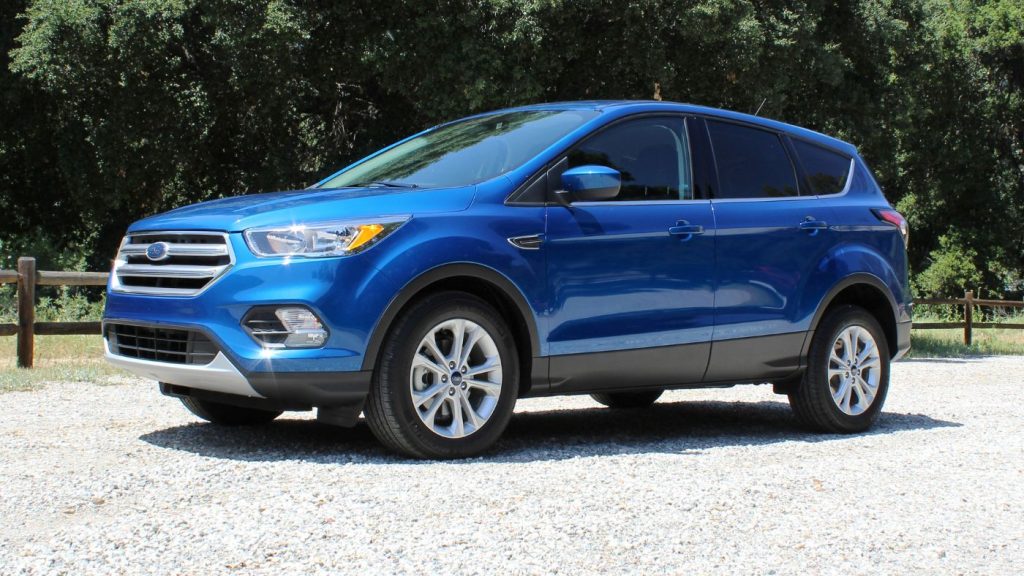
The 2.0-liter engine delivers even more spirited performance, achieving 22/29 mpg city/highway—only slightly less efficient than the 1.5-liter but far superior to the base engine. Additionally, the 2.0-liter model boasts one of the strongest towing capacities in the segment, capable of hauling up to 3,500 pounds.
Both the 1.5- and 2.0-liter engines come equipped with a new stop-start system designed to boost fuel efficiency by shutting off the engine during complete stops.
This system is impressively smooth and unobtrusive, operating so seamlessly that most drivers won’t notice when the engine shuts off and restarts. All-wheel drive is available for both turbocharged options.
Nice as it is, though, we’d happily spend another $1295 to put the heavily revised 2.0-liter twin-scroll turbo four under the hood. With output increased to 245 horsepower and 275 lb-ft of torque—from 240 hp and 270 lb-ft in the pre-refresh model—the gutsiest Escape’s more authoritative acceleration comes with a mere 1-mpg penalty in the EPA’s combined fuel-economy rating compared with the 1.5.”
Both of the Escape’s turbocharged engines come with new stop-start technology for 2017, a fuel-saving measure that even luxury cars struggle to perfect. The Escape’s stop-start feature is one of the smoother implementations out there, so seamless that I didn’t feel the need to immediately defeat the feature at startup as in so many other vehicles.”
When it comes to handling and braking, the 2017 Ford Escape continues to shine as one of the best-handling compact SUVs available, competing closely with the Mazda CX-5. Its steering is sharp and responsive, providing immediate feedback as soon as you turn the wheel.
The steering itself is light and easy to manage, which makes the Escape equally enjoyable on spirited drives and long highway journeys. A well-tuned suspension system enhances ride comfort, absorbing road imperfections while maintaining stability and minimizing body roll through corners.
Nissan X-Trail
Next up is the Nissan X-Trail, which Nissan proudly describes as “Compact on the outside, colossal on the inside.” That tagline rings true once you step inside. The X-Trail features an innovative “luggage board” system with 18 possible interior configurations to suit your storage needs.
One of its standout design features is the underfloor storage, divided into two lift-out panels with trays beneath for added convenience. This smart layout makes accessing and organizing your items easier than ever. Cargo capacity sits at 70.0 cubic feet with the seats folded and 32.0 cubic feet with them upright.
When we previously tested the top-spec Nissan X-Trail in its dCi Tekna configuration, our verdict was that “the actual driving experience has taken the back seat, and the X-Trail is a well-made family car, if not quite as practical an alternative to an MPV.”
The issue at the time was a lack of power and torque. Despite being spacious enough to seat seven, Nissan had equipped it with a relatively small 1.6-litre diesel engine.
That shortcoming has since been addressed with the introduction of a 2.0-litre dCi engine, producing 175bhp. Buyers now have the choice between a manual transmission (limited to front-wheel drive) or an automatic version, which is offered with both front- and all-wheel-drive configurations.
So, can this upgraded X-Trail position itself as a stronger competitor against the Hyundai Santa Fe, Kia Sorento, Skoda Kodiaq, or the more premium Land Rover Discovery Sport? To find out, we put the £35,025 all-wheel-drive Tekna model to the test.
In some ways, yes—but in others, not quite. The increased power and torque are certainly noticeable, but the engine is quite vocal at idle, and the CVT gearbox frequently searches between its simulated fixed gear ratios
It’s a pity, because while the refinement of the performance may not fully justify the price, there’s no denying the car now delivers stronger acceleration. With a 0–60mph time of 9.7 seconds, it’s noticeably quicker than the previous version.
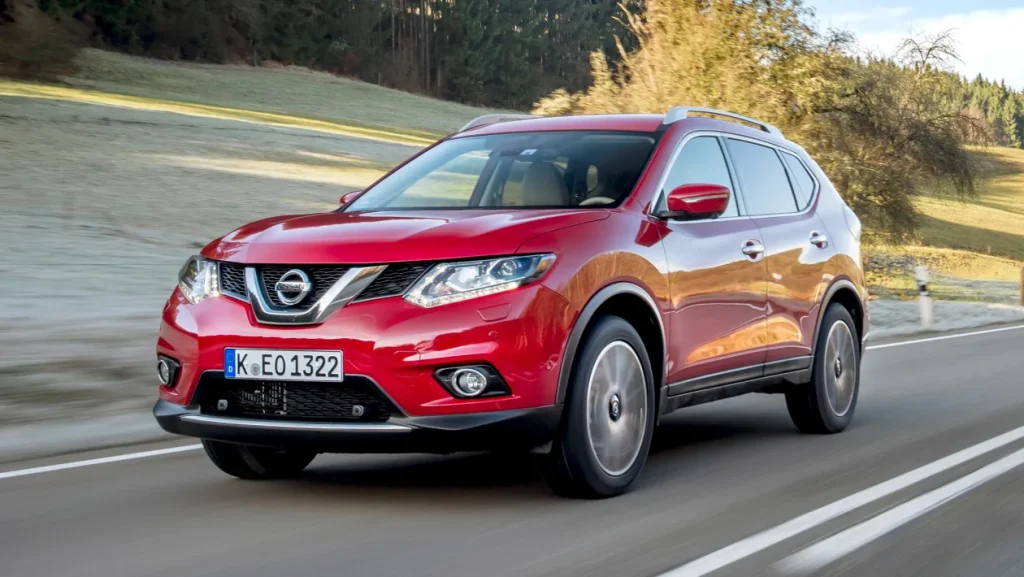
More crucially, the X-Trail now offers plenty of mid-range punch for overtaking maneuvers. On the motorway, it performs with far less strain than before, and its efficient gearing means it cruises below 2000rpm at UK legal speeds. During initial testing in Germany, the X-Trail comfortably maintained 100mph on unrestricted sections of the autobahn, where permitted.
We also explored its off-road potential with some light quarry driving. The X-Trail met expectations, performing well under the kind of conditions most owners are likely to encounter. Helpful features such as the 360-degree camera and selectable all-wheel-drive modes provide additional confidence in tight or slippery situations.
Leaving the system in ‘auto’ is generally the best option. That said, the lack of hill descent control is a drawback, and it’s even more disappointing that the automatic version’s towing capacity is limited to just 1600kg. For comparison, the manual variant can tow up to 2000kg.
Toyota RAV4
The Toyota RAV4 is all about practicality. With its expansive storage capabilities in both the front and rear areas, it’s clear Toyota designed this SUV with everyday convenience in mind. The 60/40 split rear seats can fold flat, making it simple to slide in bulky items, and the low cargo floor height makes loading and unloading a breeze.
While the cargo space itself isn’t expandable, it does include tie-down hooks to help keep your items secure. The RAV4 also comes with a height-adjustable power liftgate, allowing shorter drivers to customize the tailgate’s opening height. With the rear seats down, the RAV4 offers 73.4 cubic feet of space, and 38.4 cubic feet with the seats up.
For the 2017 model year, the Toyota RAV4 receives a comprehensive suite of standard driver assistance features, including forward collision mitigation, lane departure warning, automatic high beams, and adaptive cruise control. Additionally, a new range-topping Platinum trim level has been introduced, expanding the RAV4’s appeal to buyers seeking more upscale amenities.
The RAV4 underwent a modest update in 2016 with refreshed exterior styling and a redesigned interior, but its core mechanical setup remains unchanged since this generation launched in 2013.
Meanwhile, the compact SUV segment has become increasingly competitive, with rivals offering sharper driving dynamics and improved fuel economy. Even so, the RAV4 continues to hold its own due to its balanced nature. While it may not lead the pack in any one category, it remains a compelling all-rounder.
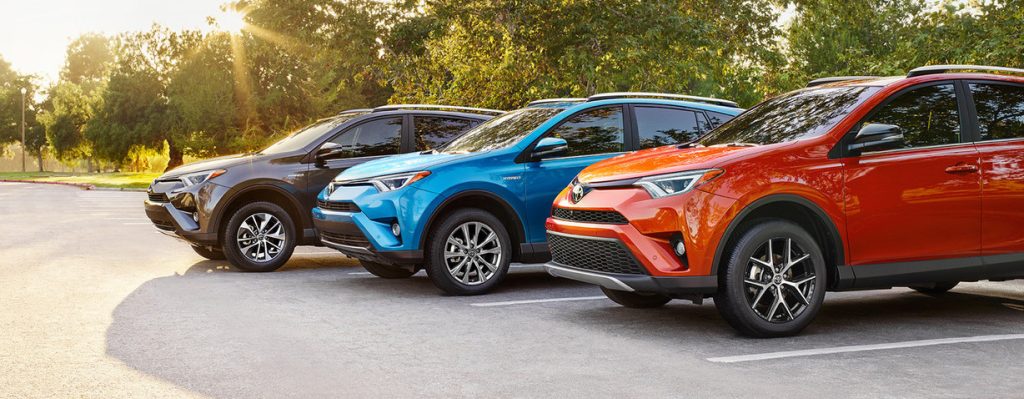
The 2017 RAV4 remains a popular choice for families and daily commuters. Their expert rating gives it a 3.5 out of 5, emphasizing its user-friendliness and practicality. Although the driving experience won’t thrill enthusiasts, its emphasis on interior comfort and cargo space makes it a practical and dependable option.
The interior also scores 4.0, with the Limited trim offering leather on the dash, seats, steering wheel, and shifter—marking a significant step up in material quality and overall design. However, while the cargo space is generous and versatile, cabin storage solutions are only average, which slightly limits its utility rating.
For buyers considering a 2017 RAV4, Edmunds recommends the XLE trim. It strikes a good balance between value and features, offering upgraded seating, dual-zone climate control, and more agreeable 17-inch wheels compared to the firmer ride of the Limited’s 18-inch wheels.
As for drivetrain, front-wheel drive is the preferred choice unless you live in an area that frequently experiences poor road conditions, in which case the available all-wheel-drive system may be worth the extra cost.
The 2017 RAV4 is offered in five trim levels: LE, XLE, SE, Limited, and Platinum. All trims come standard with a 2.5-liter four-cylinder engine that produces 176 horsepower and 172 lb-ft of torque, mated to a six-speed automatic transmission.
Both front-wheel and all-wheel drive are available across the lineup. With no mechanical differences between trims, the decision mostly comes down to desired features and comfort preferences rather than performance considerations.
Subaru Forester
If ease and convenience are top priorities, the Subaru Forester is a strong contender. Its boxy shape gives it a spatial advantage, and folding down the rear seats is made easy thanks to a single-touch mechanism. This feature is especially helpful for seniors or those with limited mobility.
The Forester includes the typical holders and bins you’d expect from a modern SUV, and its cargo space nearly triples when the rear seats are down. With a 60:40 split fold, it provides 74.7 cubic feet of cargo room when folded and 34.4 cubic feet when unfolded.
The Subaru Forester made its debut in the 1998 model year as a crossover SUV that stood slightly taller than the Impreza wagon it was built upon.
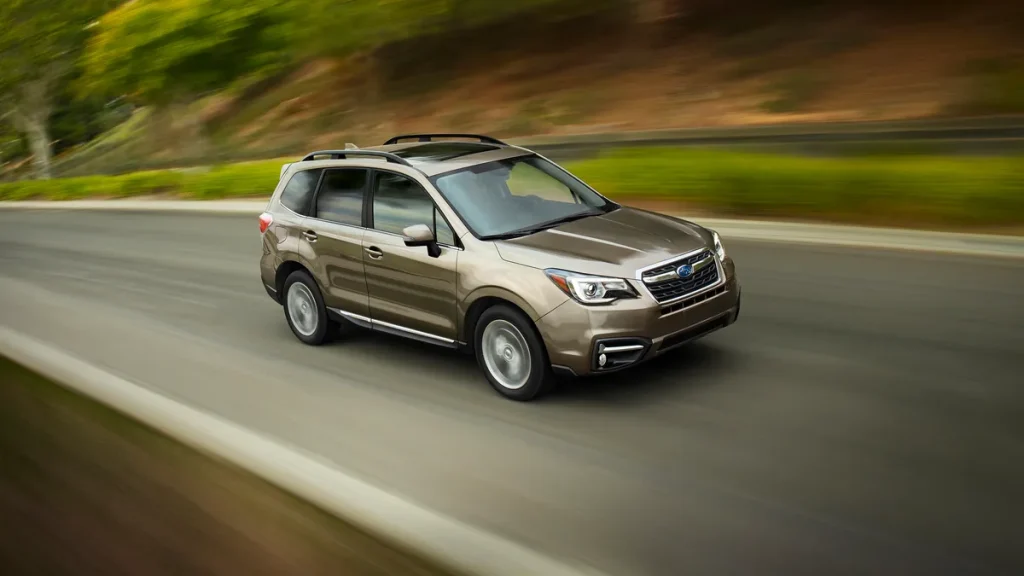
By the time the fourth-generation Forester arrived for the 2014 model year, it had evolved into a full-fledged compact SUV, standing 68.3 inches tall and measuring two inches longer than primary rivals like the Honda CR-V and Mazda CX-5.
Today, while the compact SUV segment is largely populated by tall, two-row suburban family vehicles not intended for off-road adventures, the Forester distinguishes itself.
Like all Subaru models (excluding the BRZ), it comes standard with all-wheel drive and boasts a best-in-class 8.7 inches of ground clearance—giving it more off-road capability than most of its competitors.
Honda CR-V
Topping the list is the Honda CR-V, which leads the pack in terms of cargo space. With the seats up, it already offers an impressive 39.2 cubic feet—enough to hold up to 10 pieces of luggage.
Fold the seats down and that number can go up to 25. Like the Forester, the CR-V uses a convenient seat-folding system, referred to by Honda as a “one-motion dive down” feature. This allows users to raise or lower the seats in one smooth motion.
The vehicle also includes a programmable power tailgate and an adjustable cargo floor in the rear, giving it even more flexibility for storage. Folded down, the CR-V offers a spacious 75.8 cubic feet of room.
SUVs combine practicality, ruggedness, and refined styling in a way that’s hard to match. Add in spacious cargo capabilities, and it’s no surprise that these vehicles have become some of the most popular choices.
The 2017 CR-V boasts 10 additional inches of linear cargo space with the rear seats folded down, bringing the total up to 75.8 cubic feet, an increase from 70.9 cubic feet in the previous year. This cargo space outclasses the current Mazda CX-5 and narrowly surpasses the Toyota RAV4.
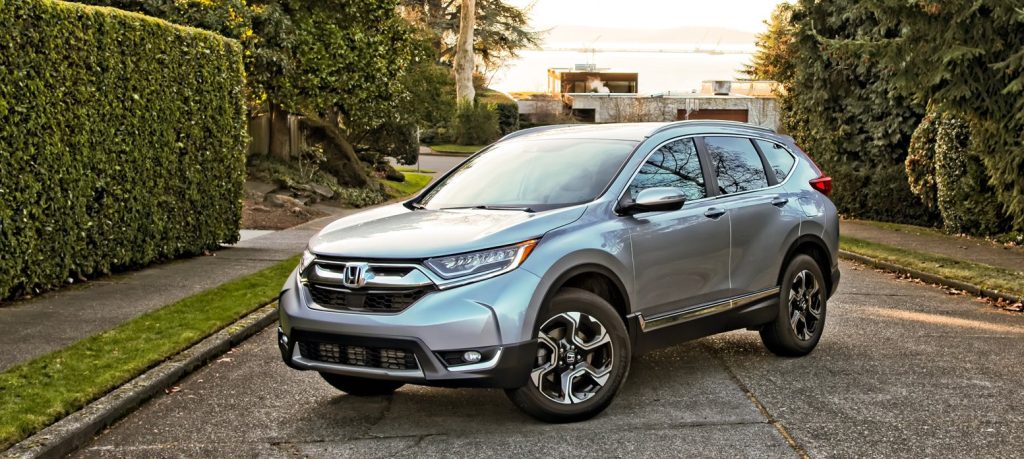
Up front, storage and customization are clearly priorities. The center console can be configured in three different ways, with a removable tray that either keeps smaller items within easy reach or stows away completely. Door pockets offer ample space for water bottles, tablets, and even old-school maps—yes, there’s room for those too.
When it comes to safety and tech, the 2017 CR-V doesn’t fall short. Blind-spot monitoring with cross-traffic alert came in handy when it saved me from a fender-bender in a crowded parking lot.
The lane-keeping assist system performs well, helping to keep the CR-V centered in its lane, although it’s important to remember that it’s an aid, not a substitute for attentive driving.
These features, along with a seven-inch touchscreen display, are standard on all trims except the base LX. The touchscreen is powered by Garmin navigation, which is intuitive though it lacks a one-box search function.
Thankfully, Apple CarPlay and Android Auto are also standard on EX trims and above, offering modern connectivity for smartphone users.
One welcome change is the return of a physical volume knob, replacing the frustrating touch-sensitive slider from the previous generation—sometimes the old-school approach just works better.
Under the hood, the base LX trim carries over Honda’s 2.4-liter engine, which delivers 184 horsepower and 180 pound-feet of torque. However, I didn’t test this powertrain.
Instead, I spent time with the peppy new 1.5-liter turbocharged engine found in EX trims and higher, the same one featured in the new Honda Civic. This engine brings welcome energy to the CR-V lineup and complements the vehicle’s overall improvements in style, functionality, and comfort.

